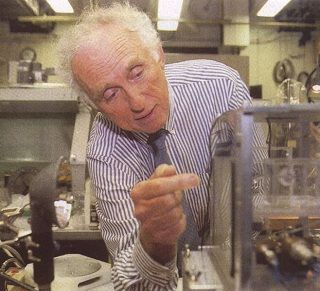Clean Energy Technologies Could Come from Unexpected Places
According to the Writer’s Almanac on Monday:
It was on this day in 1754 that the word “serendipity” was first coined. It’s defined by Merriam-Webster as “the faculty or phenomenon of finding valuable or agreeable things not sought for.”
…. The invention of many wonderful things have been attributed to “serendipity,” including Kellogg’s Corn Flakes, Charles Goodyear’s vulcanization of rubber, inkjet printers, Silly Putty, the Slinky, and chocolate chip cookies…..Alexander Fleming discovered penicillin after he left for vacation without disinfecting some of his petri dishes filled with bacteria cultures; when he got back to his lab, he found that the penicillium mold had killed the bacteria…..The principles of radioactivity, X-rays, and infrared radiation were all found when researchers were looking for something else.
A few years ago, I had the honor of interviewing Dr. Martin Perl, who, in 1971, (the same year I received my first driver’s license), received the Nobel Prize in physics for his discovery of the (elementary particle) tau lepton. Currently, Perl runs the Stanford Linear Accelerator (SLAC), and mentors a gaggle of post-graduate students, helping them develop insight into the origins and ultimate building blocks of the universe with ever-increasing precision.
I’ll never forget what he said when I asked him about the connection of high-energy particle physics with clean energy. He said, “There is none.”
“None? Not now? Not ever?” I implored. Even after carefully rephrasing the question in three of four different ways, Perl held tight to the notion that his work had no bearing to any possible breakthroughs in useful, harnessable energy.
Of course, it is he, not I, with the Nobel Prize to his credit. But given that so many of the technologies that have proved such a boon to mankind were complete accidents, I would think that a more proper answer would be, “I guess we’ll have to wait and see.”


Considering the fact that there are limited resources available for basic research, don’t you think that the opinion of this Nobel laureate is pointing to the need to refocus our federal priorities?
There are a lot of higher probability lines of research that can produce returns for mankind in the here and now.
The serendipitous events occur with or without government funding. Look at Buckyballs for instance. The carbon soccer ball shaped nano structures were produced in a lab by a U of Arizona scientist that was fooling around on his own time without a grant.
Serendipity to me is like accidentally finding food in a Refrigerator, when not found on the Dinner table; where Silver Spoons are kept. With this Serendipitous world so much used to the `Dinner on the Table’ and `Spoon feeding’ with the Silver Spoons, our Dictionary has to keep adding new and new words for the some of the age old problem of `Doing the Right thing’. Serendipity for a Father or Son is looking for the Food in all the wrong places, as for the Mother or Daughter it is Simple. ..Cooking, …a Science and an Art. (and if this response was not expected, take it as a Humorous variety to keep the Topic Interesting)
Craig,
It’s about the efficiency of dollars spent towards finding solutions.
We cannot spend infinite dollars chasing research with little probability of success. We can continue to fund particle acceleration research as basic physics research, and if something serendipitous comes out of it then that would be great… otherwise we will know more about our universe, and some other enterprising company or lab might take that knowledge and fit an application that is currently relegated to science-fiction…
Knowledge for knowledge sake is a quest worthy of funding, but we should restrict such funding only to research projects that have a high probability of significantly advancing knowledge.
In the same vein, if you only have a few tens of millions in research dollars that can be applied to alternative energy research R&D (I think we all agree that this number should be several billion/year at the least), then you should carefully attempt to find the most promising avenues of research and fund them.
In this, in an ideal world, using a particle accelerator to research energy development wouldn’t make the list… even if we were spending tens of billions/year in alternative energy R&D it wouldn’t make the list (though it would clearly be above hydrogen fuel cell vehicles, algae oil, all forms of geoengineering, and many other dumb ideas that are currently funded).
So hope for serendipity, but plan and fund based on hard probabilities.
Frank, I hope that you are not lumping Geothermal engineering research into your geoengineering black list.
Geothermal may not be a hot prospect for serendipity but it has great potential for delivering thermal energy in large quantities with little or no carbon footprint.
Larry,
I’m a fan of geothermal, and believe it could be quite lucrative if someone was to rethink it (and utilize two of our patents).
Geoengineering is a term used for crackpot ideas to try to counter global warming by changing the planet… The most popular example of geoengineering is “the Pinituba Option”, where it is proposed that we dump 10 million tons of ultra-fine ground sulfur into the upper stratosphere to increase the planetary albedo, but there are many other similarly grand-scale ideas that are all lumped together as “geoengineering”.
“So hope for serendipity, but plan and fund based on hard probabilities.” I couldn’t agree more. In fact, I’m reminded of this post that I wrote from the floor of the American Chemical Society show, which I attended with your parents (Dr. and Mrs. Doty): http://2greenenergy.com/reasonably-priced-clean-energy/21494/.
Craig,
I know you’ve consistently held a more level head in this field. That’s why I enjoy your blog.
🙂